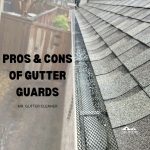Gutters are integral to maintaining the structural integrity and comfort of a home, channeling water away to protect foundations, walls, and landscapes from water damage.
Essential for home maintenance, they mitigate risks associated with heavy rain and snow, preventing water ingress that can lead to costly repairs.
Regular gutter maintenance ensures that they function optimally, extending the lifespan of the roof and siding, while also maintaining property aesthetics.
Understanding the various materials from which gutters are made allows homeowners to make informed decisions about the type best suited to their climate and home design.
Furthermore, recognizing signs of wear or blockage can prompt timely intervention, avoiding the more severe consequences of gutter neglect.
As part of a comprehensive home maintenance strategy, informed choices about gutter materials, installation, and upkeep contribute significantly to preserving a home’s value and ensuring a safe, comfortable living environment. This approach not only addresses immediate water diversion needs but also enhances the home’s overall resilience against weather-related challenges.
What Are Gutters and Why Are They Important?
Gutters are integral components of home exteriors, guiding rainwater from the roof to designated drainage areas, thus preventing it from causing damage to the home’s structure and landscaping. Their importance lies in their ability to protect the home’s foundation, mitigate soil erosion, prevent basement flooding, and reduce water staining on bricks and stone masonry. By directing water away effectively, gutters maintain the integrity and aesthetics of the home, making them a vital aspect of home maintenance.
How Do Gutters Protect Your Home?
Gutters protect homes by controlling the flow of rainwater, safeguarding the roof, walls, foundation, and landscape from water damage. They reduce the risk of structural issues, dampness, and mold growth by diverting water away from the building. Effective gutter systems prevent accumulation of water on roofs which can lead to leaks and decay, thereby prolonging the lifespan of the roofing materials and ensuring the stability of the home.
Table Of Contents:
- What Are Gutters and Why Are They Important?
- Understanding the Role of Gutters in Home Maintenance
- The Benefits of Regular Gutter Maintenance
- Installation and Types of Gutters
- Troubleshooting Common Gutter Issues
- Enhancing Home Value and Safety with Gutters
- Preparing for Extreme Weather: Gutter Considerations
What Materials Are Gutters Made From?
Gutters are typically made from various materials, each offering distinct advantages. The most common materials include aluminum, which is lightweight and rust-resistant; vinyl, known for its ease of installation and low cost; steel, valued for its durability; and copper, appreciated for its longevity and aesthetic appeal. The choice of material affects the gutter’s performance, maintenance requirements, and compatibility with the home’s design, making it crucial for homeowners to consider their specific needs and local climate when selecting gutters.
Understanding the Role of Gutters in Home Maintenance
Gutters are crucial in preserving a home’s structural integrity and aesthetic value. They function as a vital part of the roofing system, channeling water away from the foundation and walls to prevent erosion, basement flooding, and siding damage. Properly functioning gutters reduce the risk of water damage and contribute to maintaining the home’s value and appearance. They are a key element in a comprehensive home maintenance plan, requiring regular inspection and cleaning to ensure optimal performance and longevity.
What Is the Lifespan of a Typical Gutter System?
The lifespan of a typical gutter system varies based on material and maintenance, ranging from 20 to 50 years. Aluminum and galvanized steel gutters last about 20 years, while copper gutters can last over 50 years with proper care. Regular maintenance, including cleaning and repairs, can significantly extend a gutter’s service life, preventing premature replacement and associated costs.
How Do Weather Conditions Affect Gutter Performance?
Weather conditions significantly impact gutter performance. Heavy rain, snow, and ice can lead to clogs, sagging, and breakage, while extreme temperatures cause expansion and contraction, potentially leading to cracks and separations. Homeowners in areas with severe weather should consider gutter guards, regular inspections, and durable materials to ensure their gutter systems can withstand the elements and continue to protect their homes effectively.
The Benefits of Regular Gutter Maintenance
Regular gutter maintenance is essential for prolonging the lifespan and enhancing the functionality of gutter systems. By ensuring that gutters are free of debris, homeowners can prevent water damage to their home’s foundation, walls, and landscaping. Regular cleaning and inspection of gutters can also prevent the formation of ice dams in colder climates, reducing the risk of water seepage and insulation damage. Additionally, well-maintained gutters contribute to the overall curb appeal of the home, ultimately preserving the home’s value.
How Can Proper Gutter Maintenance Prevent Home Damages?
Proper gutter maintenance prevents home damages by ensuring that water is effectively diverted away from the home. This prevents structural damage, such as soil erosion around the foundation and rotting of wooden fascia boards. Clearing gutters of leaves and debris also reduces the likelihood of pest infestations and mold growth. By maintaining a functional gutter system, homeowners avoid costly repairs and maintain the structural integrity of their homes.
What Are the Signs of Gutter Failure?
Signs of gutter failure include visible sagging, leaks, or overflow during rainstorms, indicating blockages or damage. Rust, holes, and separated joints in the gutter are also indicators of deterioration. If water is not being effectively channeled away from the home, or if there are areas of standing water in the gutters, these are clear signs that the gutter system is not functioning correctly and may require repair or replacement. Regular inspections can identify these issues early, preventing more extensive damage and ensuring the gutters continue to protect the home effectively.
Installation and Types of Gutters
Choosing the right type of gutters and ensuring proper installation are pivotal for maximizing their effectiveness and longevity. Gutters come in various materials and styles, each with its advantages and considerations. Proper installation by professionals or informed DIY homeowners is crucial to ensuring that gutters perform their functions effectively, protecting the home from water damage and contributing to its overall aesthetic.
What Are the Different Types of Gutters Available?
Several types of gutters are available to homeowners, each suited to different needs and preferences. The most common types include K-style and half-round gutters, known for their capacity and suitability to various architectural styles. Materials vary from durable aluminum, economical vinyl, sturdy steel, to elegant copper. Each material offers a balance of longevity, cost, and aesthetic appeal. Selecting the right type depends on the homeowner’s climate, budget, and home style.
DIY vs. Professional Gutter Installation: What to Consider?
When installing gutters, homeowners must decide between DIY and professional installation. DIY can be cost-effective for those with the right skills and tools but requires a good understanding of home exteriors and safety precautions. Professional installation, while more costly, ensures that gutters are correctly sized, securely fitted, and optimally positioned for the home’s specific needs. It often comes with the added benefit of warranties and professional advice on maintenance and repair, making it a valuable investment for long-term home protection.
Troubleshooting Common Gutter Issues
Effective troubleshooting is key to maintaining gutters’ functionality and longevity. Homeowners often encounter a range of common issues that can hinder the performance of their gutter systems. Understanding these problems and knowing how to address them promptly can prevent minor issues from escalating into major damages, ensuring the gutters continue to protect the home effectively.
How to Identify and Fix Leaks in Gutters?
Identifying and fixing leaks are crucial in gutter maintenance. Leaks usually occur at joints between sections or where the gutter has been punctured. To locate leaks, inspect the gutters during a rainstorm or use a hose to simulate rainfall. Once identified, small holes or cracks can be sealed with gutter sealant, while larger damaged areas may require patches or replacement sections. Regularly clearing debris from the gutters also prevents water buildup and subsequent leaking.
What Are the Best Practices for Unclogging Gutters?
Unclogging gutters is essential for preventing water damage and maintaining proper water flow away from the home. The best practices include regular cleaning, especially after heavy storms or during autumn when leaves are likely to accumulate. Use gloves, a gutter scoop, or a garden hose to remove debris, and consider installing gutter guards to minimize future clogs. Ensuring downspouts are clear and water flows freely is also crucial in maintaining an effective gutter system. Regular inspections can help identify and address clogs before they lead to more significant issues.
Enhancing Home Value and Safety with Gutters
Gutters not only play a functional role in directing water away from the home but also contribute significantly to the aesthetic appeal and safety of a property. Well-maintained gutters enhance a home’s exterior look, increase its market value, and prevent various health and safety hazards. Understanding how gutters contribute to the overall well-being of a residence allows homeowners to appreciate and prioritize their upkeep.
How Do Gutters Contribute to Home Aesthetics?
Gutters contribute to home aesthetics by providing a clean, finished look to the exterior. They can be color-matched to blend seamlessly with the home’s design or stand out as a decorative feature. Beyond their visual appeal, gutters help maintain the appearance of the home by preventing unsightly water stains and damage to siding and landscaping. When chosen carefully and maintained, gutters are an integral part of the home’s curb appeal and overall design.
What Are the Safety Considerations with Gutter Systems?
From a safety perspective, gutters prevent water accumulation around the foundation, which can lead to slippery surfaces and weakened structural integrity. By managing water flow, gutters reduce the risk of mold and mildew growth, which are health hazards. Properly functioning gutters also prevent ice dam formation in colder climates, reducing the risk of icicles and ice patches that can pose dangers to residents and visitors. Ensuring that gutters are securely attached and free from obstruction is crucial in safeguarding the home and its inhabitants.
Preparing for Extreme Weather: Gutter Considerations
Extreme weather demands special consideration for gutter systems. Homeowners need to prepare their gutters to handle heavy rainfall, snow, and ice, which can all exert additional pressure on guttering systems, leading to damage or failure if not properly managed. Preparation and modifications can significantly reduce the risk of overflows, breakages, and subsequent water damage to the property, ensuring that gutters remain functional and effective regardless of the weather conditions.
What Modifications Are Needed for Gutters in Heavy Rainfall Areas?
In areas prone to heavy rainfall, gutters may require additional capacity or reinforcement. This might involve installing wider or deeper gutters, adding extra downspouts to handle the increased water volume, or reinforcing the existing guttering system to withstand the weight of the water. Seamless gutters or gutter guards can also be beneficial in these areas, preventing leaks and blockages that can lead to overflows during heavy downpours.
How to Ensure Gutters Are Ready for Winter Weather?
To prepare gutters for winter weather, homeowners should ensure that all debris is cleared from the gutters and downspouts, allowing water to flow freely and preventing ice dam formation. Installing gutter guards can prevent the accumulation of leaves and debris that can clog gutters and contribute to ice dams. It’s also important to check that gutters are securely attached to the house and that any minor repairs are addressed before the onset of cold weather to prevent damage from snow and ice accumulation. Heat tape or heated gutter cables can be an additional measure for preventing ice dams in particularly cold areas.


